Plant stress resistance-related GmSIZ1a/b protein and coding gene and application thereof
A technology for plant stress resistance and coding genes, which is applied in the field of GmSIZ1a/b protein and its coding genes and applications, and can solve unclear problems
- Summary
- Abstract
- Description
- Claims
- Application Information
AI Technical Summary
Problems solved by technology
Method used
Image
Examples
Embodiment 1
[0044] Embodiment 1, the acquisition of GmSIZ1a / b gene
[0045] 1. Primers: F1 (forward primer): 5'-CGGGATCCATGGATTTGGTACCGAGCG-3'; R1 (reverse primer): 5'-CGGGATCCTCTCTGAATCTGAATCAATAGAA-3'.
[0046] 2. Extract RNA from soybean leaves and reverse transcribe to obtain cDNA.
[0047] 3. Using the above cDNA as a template, using the primer pair designed in step 1, PCR amplifies the GmSIZ1a / b gene.
[0048] 4. The amplified product was sequenced, and the sequencing results showed that: the GmSIZ1a protein is shown in sequence 2 of the sequence listing, and its coding gene sequence is shown in sequence 1 of the sequence listing; the GmSIZ1b protein is shown in sequence 4 of the sequence listing, and its coding The gene sequence is shown in sequence 3 of the sequence listing.
Embodiment 2
[0049] Embodiment 2, the acquisition of transgenic plants
[0050] 1. Construction of the carrier
[0051] The GmSIZ1a / b full-length cDNA obtained in Example 1 and the pCambia1302 vector were double digested with restriction enzymes HindIII and NcoI respectively, and ligated to obtain a recombinant vector. Then, the AtSIZ1 promoter region was connected into the recombinant vector respectively to obtain the pCambia1302-ProAtSIZ1:GmSIZ1a:GFP vector and the pCambia1302-ProAtSIZ1:GmSIZ1b:GFP vector, which were verified by sequencing.
[0052] Sequencing results show that: the GmSIZ1a gene sequence inserted between the HindIII and NcoI restriction sites of the pCambia1302-ProAtSIZ1:GmSIZ1a:GFP vector is shown in the 1st-2643rd nucleotide in sequence 1, indicating that the vector is correct; in pCambia1302-ProAtSIZ1 : GmSIZ1b: The GmSIZ1b gene sequence inserted between the HindIII and NcoI restriction sites of the GFP vector is shown in nucleotides 1-2640 in Sequence 3, indicating ...
Embodiment 3
[0056] Example 3, GmSIZ1a / b Complementary Transgenic Plants Detecting Heat Stress-Induced SUMOylation Levels
[0057] After placing the transgenic Arabidopsis sample obtained in Example 2 at 37° C. for 30 minutes, the total protein was extracted. The protein extraction solution included: NaCl, 5% (w / v) SDS, 0.5% (v / v) NP40, 6mMEDTA, 3mMDTT, 1mMPMSF and 30% (v / v) glycerol.
[0058] The protein concentration of the transgenic Arabidopsis sample obtained in Example 2 was determined to be 20 g / L by Bradford protein assay reagent (Cat: CW0013, CWBIO, Beijing, China). The extracted protein was separated by polyacrylamide gel electrophoresis, and after transfer to the membrane, it was detected by western blot with anti-AtSUMO1 antibody.
[0059] The results showed that compared with Arabidopsis siz1-2 mutants and plants transformed only with empty vectors, the SUMOconjugates content of plants transformed with GmSIZ1a / b increased and returned to the level of wild-type Col-0, indicati...
PUM
 Login to View More
Login to View More Abstract
Description
Claims
Application Information
 Login to View More
Login to View More - R&D
- Intellectual Property
- Life Sciences
- Materials
- Tech Scout
- Unparalleled Data Quality
- Higher Quality Content
- 60% Fewer Hallucinations
Browse by: Latest US Patents, China's latest patents, Technical Efficacy Thesaurus, Application Domain, Technology Topic, Popular Technical Reports.
© 2025 PatSnap. All rights reserved.Legal|Privacy policy|Modern Slavery Act Transparency Statement|Sitemap|About US| Contact US: help@patsnap.com



